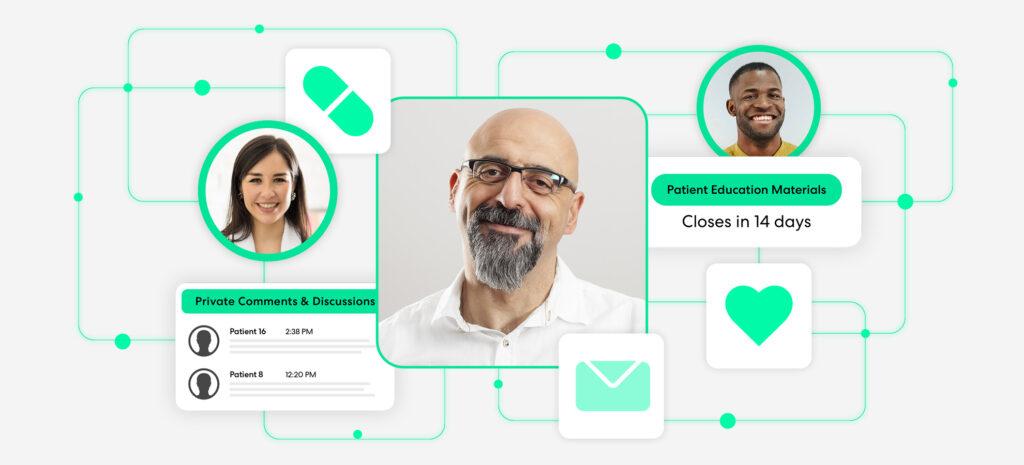For the last two decades, the world of healthcare delivery has been in the midst of an evolution. Medical professionals, public healthcare providers, and policy experts increasingly sought new strategies to close the quality-of-care chasm and to ensure that all patients received the best care experience possible.
In response, the entire healthcare system has undergone a gradual transition away from a traditional fee-for-service care model to a patient-centered approach.
But what does patient-centered healthcare mean? Isn’t all medical care, by definition, focused on the patients? And how does patient-centered healthcare fit within an overall insights management strategy?
Today, we’ll answer these questions and discuss why every covered entity must embrace this model to enhance the patient experience.
What is patient-centered care?
At its essence, patient-centered care is about recognizing that each person that walks into a clinic, doctor’s office, or hospital is a unique individual. Thus, they need personalized care, which is the central tenet. Ronald Epstein describes this notion as follows:
“Patients are known as persons in the context of their own social worlds, listened to, informed, respected, and involved in their care—and their wishes are honored (but not mindlessly enacted) during their health care journey.”
In the past, healthcare was more focused on driving traditional clinical outcomes and increased revenues. But this attitude tends to denigrate the care model. Patient centricity within a value-based care model is about being respectful of and responsive to each person’s needs in terms of how care is to be delivered and how each individual patient outcome is measured.
Why does patient centricity matter?
A move to a patient-centric model forces healthcare and life science companies to rethink the way they interact with patients and provide care and develop robust patient engagement strategies. Ideally, this should lead to better care outcomes at lower costs. If done correctly, this should lead to:
Improved patient satisfaction and retention – When patients are happy with the care they’ve received and feel as if they are heard, they’ll be more likely to return to their care provider in the future. Furthermore, if they have a positive experience, they’ll be more inclined to speak positively to others or even provide recommendations about the care they received.
Reduced readmissions – Patients that are communicated with and feel as if they’re playing an active role in the process may be more likely to follow their doctor’s orders, follow treatment recommendations, and stick to their medication schedule. This helps greatly reduce the number of preventable readmissions.
Cost reductions – From a research perspective, including patients in processes such as clinical trials leads to improved data quality and faster timelines—all of which result in significant cost reductions.
Increased HCAHPS scores – HCAHPS are amongst the most critical measures used to calculate value-based incentive payments. Happy and healthy patients result in higher HCAHPS, which in turn, bolsters a care provider’s reputation.
Patient-centered health strategies
So, what are strategies that a healthcare provider can employ to embrace a patient-centered care model? They include:
Make patients active participants
Modern patient consumers are no longer happy to be passive participants in their care provision. They don’t want to be beholden to the whims of doctors and nurses, feeling as if they don’t know what is happening or don’t have any say in the matter. Instead, engaging patients is essential as patients increasingly want to be empowered by playing a more proactive role in their care journey.
Put simply, patients need to be involved in each step of the care experience. Naturally, what this looks like may differ from patient to patient. The points of patient engagement in healthcare can differ according to:
- Medical condition
- Age
- Health status
- Health history
- Socio economic status
That said, each patient must be brought into the fold and made to feel as if they have a say in the matter. They must be asked what they want or need. It’s their health after all. So the final decision should be theirs as well.
It’s only natural for a medical incident to leave a person feeling scared and powerless. However, when they’re involved in the matter, they can be more confident in their treatment plan and enthusiastic throughout the journey. Studies also indicate that engaging patients and prioritizing patient needs often leads to better health outcomes.
Communication is key
A lack of communication is one of the most common complaints made by patients in regard to their healthcare delivery. According to Becker’s Hospital Review:
“Fewer than 1 in 20 online complaints cite diagnosis, treatments and outcomes in healthcare as unsatisfactory, whereas more than 19 of 20 unhappy patients said inadequate communications and disorganized operations drove them to post harsh reviews.”
Asking patients to simply “trust the experts” is no longer a satisfactory response—if it ever was. Any time a patient is engaged, they can’t be left in the dark about what is happening. Instead, from admission to discharge, it is essential that their health care provider shares all relevant information to be shared fully and in a timely manner.
Ideally, education materials should be:
- Personalized to them and their unique situation
- Easy to understand
- Available for review whenever they desire
- In a physical and digital form
Armed with this information, patients can feel more confident in their treatment plan, care team, and care journey. And having knowledge of what’s happening and what’s being done could alleviate many of their concerns and lead to quality improvement in the patient experience.
As a patient’s stay comes to an end, communication is more important than ever. Proper discharge planning—which includes all the vital details they need about medications, symptoms, post-care, etc—is essential for ensuring that a patient isn’t readmitted. And post-discharge phone calls and follow-ups are an essential way that healthcare providers can remind patients that they are viewed as an individual with inherent value.
Involve stakeholders
By gathering input from patients, program operators, and decision-makers, it becomes much easier to develop and deliver solutions that are made to reflect the priorities of all parties. When it comes to clinical trials, involving stakeholders is necessary to ensure that initiatives are installed effectively. Plus, when all stakeholders have a say, you’re more likely to benefit in:
- Cost savings
- Greater trust
- Smarter decision making
- Improved resource allocation
- Reduced risks
- More successful outcomes
For this, you must create a stakeholder engagement strategy that identifies important stakeholders, classifies them into buckets, and then strategically engages them accordingly. Here technologies like Within3 make it possible to digitally engage all key parties, even when operating in a remote world.
Comfort matters
Throughout the care journey, a patient’s physical comfort and emotional well-being should be paramount. In the words of Hippocrates, a doctor’s oath is “To cure sometimes, to relieve often, to comfort always.” Per research via the British Medical Journal, comfort, or a lack thereof, is one of the most fundamental factors a patient considers when rating their overall experience. “A service that fails to provide high-quality care that includes the promotion of comfort, or recognize avoidable suffering as a source of harm, means that patients and their families have been let down by those who are meant to care for them. Overall, reducing unwarranted variability in care…is a crucial aspect of quality person-centered care in contemporary healthcare settings.”
When researchers interviewed patients, they described comfort as a combination of four factors:
- Relief from pain or emotional or physical distress
- Feeling in control of their treatment plan
- Feeling positive and safe
- Feeling cared for and valued
For care providers, strategies like hourly rounds, bedside shift reports, and patient care boards ensured that patients were comfortable. And if that wasn’t the case, these patient-centered approaches allowed them to remedy the situation as quickly as possible.
Encourage family and caregiver involvement
Although patients should be involved in their care, it’s important to remember that they may be suffering, on medications, or simply overwhelmed by everything going on. This can lead to forgetfulness or confusion. However, including family members and caregivers in the process, deputizing them as key players in the care journey is one of the most powerful patient safety drivers.
Healthcare providers should include both the patient and their personal care team in conversations about their treatment, medications, discharge planning, etc. Having an extra set of eyes and ears can help prevent oversights. It also gives the patient another advocate in their corner, which should inspire confidence and comfort every step of the way.
Tools to strengthen patient centricity
Whether it occurs in the hospital or in life science development, the heart of value-based care involves a patient-centric approach to the care journey. Their voice and concerns must not simply be heard but championed in every aspect of care delivery.
Increasingly, patient-centered technology is empowering care providers to embrace a patient-centric approach by:
- Encouraging patient participation
- Providing open-ended communication
- Involving stakeholders
- Ensuring comfort
- Enlisting the assistance of family and caregivers
When it comes to a patient-centric approach to clinical trials and PFDD (patient-focused drug development), a virtual engagement platform is part of the insights management process that can enable life science companies to gather crucial feedback at every stage of the product development lifecycle.
Curious about how insights management supports patient centricity? Read our blog post to learn more.






